- Home
- Blog
- NEWS FROM THE FIELD - December 2025
NEWS FROM THE FIELD - December 2025
December 2025, posted by Isabelle
December 2025
Milou's very Own Blanket !
What a stunning Gift!
Life works in mysterious ways and brings wonderful surprises.
i came home one day to find a note stuck on my back door. A lady from the local town was in search of alpaca fleeces to spin and weave into blankets. Needless to say that this was enough to prick my curiosity and I quickly got in touch with her.
Anne Marie took me on a deep dive into her craft, explaining each step of the processing before the fibre can even be spun into yarn. It requires buckets of patience and dedication and the skills to produce a piece of outstanding quality and beauty.
From This!
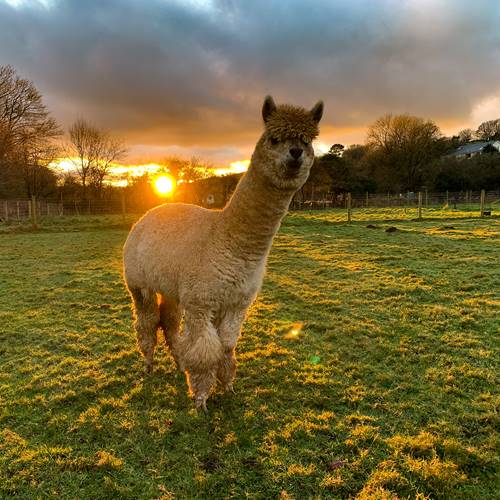
To This!
And the In-Between
- Shake or use a fibre tumbler to remove the dust.
Sort and skirt the fleece - remove any rough fibres or any rough guard hairs, so that only the best, softest, finest fleece is left, and pick out any remaining vegetable matter - leaves, twigs, etc.
- Scouring- washing by hand - can take 3 - 6 washes depending on how dusty or dirty a fleece is. Then the fleece is laid out to dry.
- When dried, a flick carder is used to gently ‘tap’ open the tips of the fleece locks.
Locks of fleece are then fed into the drum carder to make batts of fibre ready for spinning.
- The batts are then spun into a chunky weight 2 ply yarn.
5.This is wound on a niddy noddy to make a skein.
6.Skeins are then gently washed in warm water to set the twist in the yarn. When dry the skeins are wound into balls of yarn in readiness for weaving.
7.Then the yarn is woven on a rigid heddle weaving loom to make a blanket.
8.It is then washed to allow the alpaca fibre to finally settle into shape and come to it's full potential.
9. It is then pinned to dry flat. When dry it is pressed and then gently brushed.
Each one takes about 1.8 kg of fibre to make a cosy winter weight blanket.
Anne Marie's sheep and alpaca fleece blankets are…
100% biodegradable
Breathable
100% renewable
Temperature regulating
Soft, cosy warm
Natural
Durable
Ecofriendly
Sustainable
Traceable
Water repellent
Strong
Wicking
Unique
Odour resistant
Fire retardent
British, locally sourced
Washed and processed by hand
Anti-static
Supporting local farmers and small holders and championing traditional and rural skills.
Encouraging slow living and sustainability.
Fleece that is often thrown away, can be found a use with care and time: It is a valuable product that can be made into something beautiful.
This blanket came from sunshine, rain, fields of green and of course the stars of the show.. the sheep, the alpacas. And then in time, it can be returned to the earth, from where it came -
it is compostable.
If you have enjoyed this blog and it has succeeded in pricking your curiosity, Anne Marie will be delighted to answer any query you may have.
She can be contacted directly
arowe084@gmail.com
November 2025
A GLIMPSE INTO ALPACA FLEECES
The rainy, temperate climate of England or even Scotland hardly offers a suitable habitat for alpacas. They originate from Peru, more precisely the Andes known for their dry, extremely cold and unforgiving climate. Alpacas along with other members of the camelid family, llamas, vicunas and guanacos, are built to sustain such harsh living conditions. They are very compact and hardy animals gifted with a thick and dense coat that not only keeps them dry but insulates them from the intensely freezing cold of the winter months. Their fibre has been praised for its softness and fineness and for being hypoallergenic as it is lanolin free..
The quality of an alpaca fleece is measured in micron and how much crimp it holds. The smallest the micron, the softer the resulting yarn will be and the least amount of itchiness it will cause when wearing the knitted garment. Only a small part of the animal fleece is used for spinning purposes, Called the blanket, it is harvested once a year from the back and sides of the animal as shown on the picture of Topaz above. The rest of the fleece, comprising the neck, underbelly and legs may be used for carpet making, stuffing or insulation or just be discarded.
One of the parameters of breeding alpacas is to follow a genetic line of animals who will grow hair of the finest quality. Not all animals are born with such specifics and their fleece may not necessarily meet the criteria required by the spinning industry.
It takes hundreds of animals to make a profitable business out of alpaca fleeces. Processing the fleeces is a costly process as they need to go through various and time consuming stages before even being ready to be spun into yarn. This only becomre worthwhile with a large herd of animals. Most small holders discard the fleeces as there is little or no money to be made from them.

MY VERY OWN ALPACA EXPERIENCE
My herd is tiny and counts only 5 animals who live in a closely tight knit.
As i have invested myself deeply in the care of my animals, i decided to fulfill my experience of alpaca keeping to its final stage: Have their fleeces processed and spun into yarn.
i have kept their fleeces (only the back or blanket) for 2 to 3 years until i collected enough of each color to make it worthwhile, hoping to al least recover my cost.
Shearing my animals has always been an immense pleasure, the touch of their hair as i am shearing is truly a sensual experience, the moment of trust i spend with them as they let me run the shears through their coat has been inspirational and the resulting yarn spun into a neatly presented soft and smooth ball has been incredibly rewarding. Alpaca yarn is such a noble, luscious and luxurious gift.
The colours are the natural colour of the animals and the yarn you will receive comes from the very animal pictured on the product page. 100% traceable right down to the very animal!
QUALITY
The batches we currently have for the black, brown and dark beige yarns were made from fleeces when the animals were 2, 3 and 4 years old.
The off-white yarn comes from Willow who is older and therefore does not have a fleece as soft as a younger animal.
Nevertheless, it is still alpaca yarn and softer than sheep.
WHAT TO KNIT OR CROCHET
Alpaca yarn doesn't have the spring quality of sheep wool. So large pieces tend to stretch and fall out of shape.
It is best suited to knit or crochet small pieces, such as hats, gloves and scarves.
CARING FOR THE ANIMAL WHILST SHEARING
IMG_0494.jpg 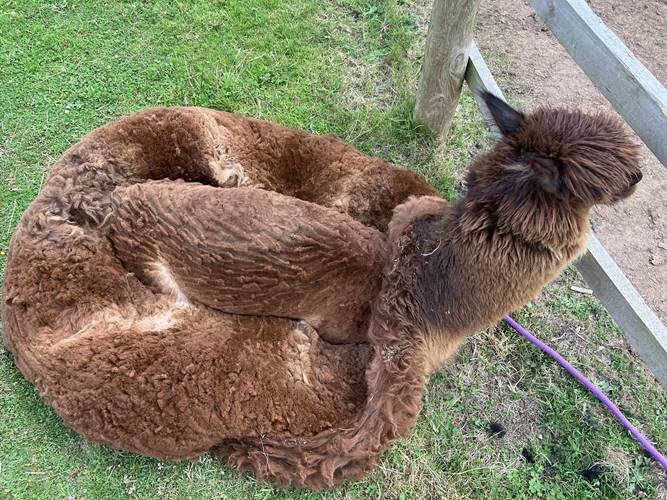
With their long and unusual neck, alpacas may look a little exotic and amusing to us. They have a luscious, smooth coat that make them look like Teddy bears and it is hard to resist the urge to touch, pet and cuddle. This doesn't happen often as these animals do make it truly hard work for us to look after them. Although there is nomore alpacas in the wild and they have lived as domesticated animals for a very long time, they have retained a strong wild instinct and do not give their trust with ease. An enormous amount of time and bagfuls of patience are the pre-requisits before contemplating the idea of keeping alpacas. Their first reaction is very much rooted in a fear and flight mode which makes every little bit of care they need to receive feels like an expedition. Shearing is no exception and is possibly the worst for the animal. They really do not help themselves. Videos on shearing alpacas can easily be found on youtube. It is a process that i used in my early days as an alpaca keeper as i didn't know any better. I have always profoundly dislliked it and have done my best to get my animals to get used to my touch. I have succeeded mostly and my youtube channel shows how much i have achieved. I shear my animals myself with hand shears except for the boy Milou. I have so far got to admit complete failure on the shearing front.
APRIL 2025
Fun Fact!
Do Alpacas spit?
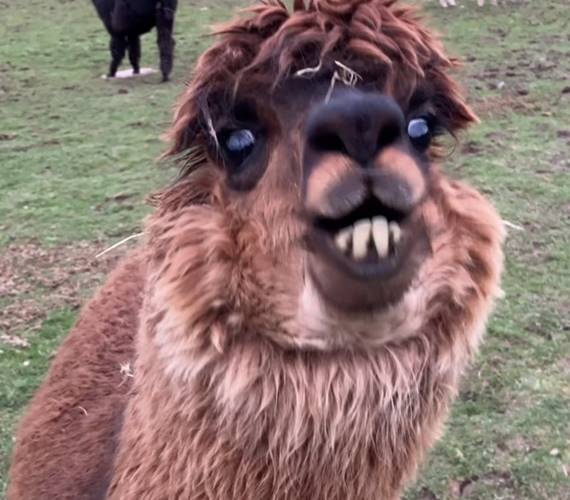
Alpacas like the other members of the Camelid family, of which llamas and camels are the most well-known members, do spit. Unlike what the peruvian adventures of Tintin and the unfortunate Captain Haddock make us believe, they do not spit water or saliva. They bring up the contents of their stomach back up their long neck and project it in a strong jet at the offender: A mixture of chewed-up grass with whatever digestive juices are lurking in the depth of their stomachs. Although it doesn’t hurt, it is a stinky and unpleasant blend which has proven to be very effective at putting us all off. Goats, horses and myself have learnt our lesson the hard way. This is so disgusting that even alpacas do not like the taste of their own spit. They will drop their bottom lip, unable to eat, until the taste and smell of the unsavoury mix have left their mouth.
So luckily, they do not spit for fun. Spitting is used either as a warning or a defensive tool. A situation needs to arise in which they will feel threatened or challenged by a member of another species, or will find themselves caught-up in a strong argument with one of their own before deciding that they have no other choice but regurgitate the latest meal in their faces!
Of course, alpacas have learnt the trick of their own trade and are most adept at spitting whilst avoiding to be spat at. The attacker will approach the attackee from behind, spitting at his head but to the back of it, knowing full well that the attackee wont be able to face him to return the favour before receiving the full blow of his spit first. The 2 opponents are therefore both spitting forward into thin air. If the disagreement turns into a more serious affair, they will face each other, pushing against each other's chest and entertwining their neck with their heads pointing skywards as both are trying to spit into each other's face whilst avoiding the adversary's spit. Yet, again, another precious meal wasted into thin air. Among our domesticated animals, fights do not last long, are never that serious - in my experience so far - and always end up with the 2 adversaries parting ways, drooling green paste from a dropped bottom lip whilst looking dejected probably more due to the state of their own mouth than the cause of their desagreement!
Some individuals spit more easily than others. Topaz, pictured above in a ‘I'm about to spit at you’ mood, loves to take her perceived offenders by surprise. It can get the unsuspected victim – me, quite often - unaware although most of the time, she is kind enough to give me a warning: Eyes, ears along with the unmistakable movement of the food bowl climbing up the ladder of her neck. The best tactic is to follow the example of her peers, turn my back on her and carry on with what I was doing whether she likes it or not. And if my back does get caught, it doesn’t have a nose to be hit by the unmistakable stench of her half digested meal or bare skin to itch with the acidic juices of her stomach!
NOVEMBER 2024
Counting our eggs!

I moved to Devon in 2009, coming from London and having led a city life since I was born. I had never been close to a live chicken, let alone held one.
Shortly after arriving in the countryside and encouraged by my father who had an experience of life a lot more down to earth than i had, i took my three sons to the nearest poultry breeder. We came back home, proudly holding a box with our very first 2 hens. We named them Basil and Lola after a brand of the boys' soft toys! As i didn't want to look like a wimp in front of my boys, I grabbed all the courage i had and forced myself to put my hands in the box, hold the birds with my bare hands and transfer them in their newly built hutch. I can laugh at myself now, at my fear of such sweet and harmless creatures.
I have an uncontrolable urge for freedom that applies to every sort of pets i have ever had to look after. It was not long before i decided to open the door of their small run to the expanse of the country side, giving them the freedom to forage for their own food. It has been somewhat of a roller coaster to keep them safe from the wild life until we moved to our new field in 2013. The configuration of the land, bordered by the river on one side and the road on the other, crossing each other at each end in an eye shape, does not offer an inviting lay out to predators as they have nowhere to escape to. The alpacas have helped a little and any fox faced with Topaz, her brother Milou and mother Calypso marching in an united front towards him will be an intimidating sight and one to reckon with.
Over the years, my flock has grown including now ducks and geese, all free to roam, eat, bathe in the sun, splash in the river, play and fight, settle disputes, mate, raise chicks, ducklings and goslings, in short enjoy life to the fullest.
It has taken me a little while to get to the point of this post, but I am finally there.
i do not feed my birds any man-made food. They get given a little corn every morning as a treat. Other than that, they roam the land all day in search of food. They are out by dawn - or there about- and back in their stable by dusk. They lay in the spring when the breeding season start. They do not lay everyday but will lay for many years. My oldest hen whas 11 years old and was still laying for a few weeks every year. Some hens have a stronger maternal instinct than others. They will feel the need to sit, sometimes twice a season, and raise their youngs. They will teach them how to forage and rely on themsleves for food. By the end of August, September, the breeding season is over and the egg production is practically over as well. Chickens are not meant to lay eggs all year round. Like all birds, they follow the yearly cycle of life: breed and raise youngs in the spring and summer, moult to various degrees in September/ October, grow new feathers to keep them warm and toasty for the winter months so they are all strong and ready for the cycle of life to repeat itself.
Fortunately for us, the birds lay far too many eggs and most of them would go to waste if we were not here to collect them. The quality of these eggs is like nothing seen in supermarkets. The yolk is a deep orange colour. Its consitency is thick and sticky with an incredibly rich flavour.
This may not be the solution for food production. It will appear unsustainable on a large scale and some of you may raise an eyebrow reading my story. I wanted to make a point and show a different picture of living with animals and co-existing with them in a respectful and harmonious way as opposed to exploiting them ruthlessly on an industrial scale.
I watch my birds go about their life, the body language they use between themselves and across species, their personality as, although we might see them as just chickens, they are all different with their unique personality trait. I have witnessed and loved the trust they put in me looking after them. i have smiled and lauged on many occasions at their interactions and reactions. They have no worries in the world and live their life fully in the present moment. As i stand in the middle of the field, watching and observing, i cannot but be caught up by the peace they bring out by just being. They feed the soul, soothe the mind and bring peace to the heart. They may just be chickens but it is a privilege to live with these animals and enjoy the unbeatable quality of their by-products.
Perhpas it is not just about counting our eggs!
OCTOBER 2024
Gandalf, the swan!
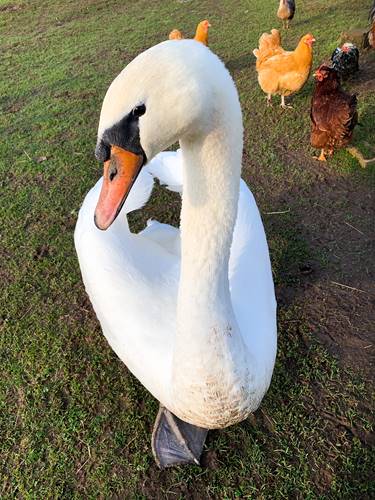
We had the pleasure to host a very unusual guest. A swan, (he/she, I never quite figured out which it was) walked from the river onto our land one day and settled down at the farm, cleary attracted by the company of our flock and reassured that their home would offer him a safe haven for his short holiday.
I called him Gandalf - not that i am a fan of the Lord of the Rings - but i thought that his majestic gait and poise had some sort of similarity with the world re-known wizard.
Gandalf settled down beautifully and became comfortable with my presence etremely quickly. My sons did not share the same confidence and warned me repeatedly that i was about to pay a high price for my sudden and irresponsible friendship with a bird of this size. They were of the opinion that a bashing of Gandalf's wings and a taste of his serrated beak were rapidly heading my way and woud leave me crippled for life!
None of their predictions happened and Gandalf quickly learnt to adapt his life style to our ways. It was an absolute pleasure and privilege to share a moment with this huge and magnificent bird. He was polite and gentle, always moving slowly and with consideration, never showing any agression or anger. He had put his turst in myself and all the inhabitants of the farm without question.
Not quite all the inhabitants in fact, the geese, always on the look-out for anything that could disrupt their peace and threaten their little world, were not too happy with this large intruder and behaved towards him like a gaggle of thugs. Gandalf, despite his towering stature, decided it was best to back down and remain out of harm's way.
Unfortunately, despite his size, Gandalf was still potential prey and received one night, the close attention of a fox. He escaped unscathed except for an injury to one of his legs. Unable to walk properly and most certainly feeling weakened and unsafe, he went back to the river to take care of his wounded leg. He laid it carefully onto his back, and stayed in the same spot for a few days, close to the bank, avoiding the powerful current raging in the middle of the river. Despite his effort to stay with us, little by little he drifted down stream to my utter disapointment.
I went searching for him a few days later and found him in a little creak, away from the turbulence of the water. I then lost sight of him.
I am always hoping that Gandalf made a ful recovery from his unfortunate encounter, will come back or live long enough to tell tales and inspire his kind to pay us a visit.
That was truly a lovely experience.
JULY 2024
All About Dolly Poppins!
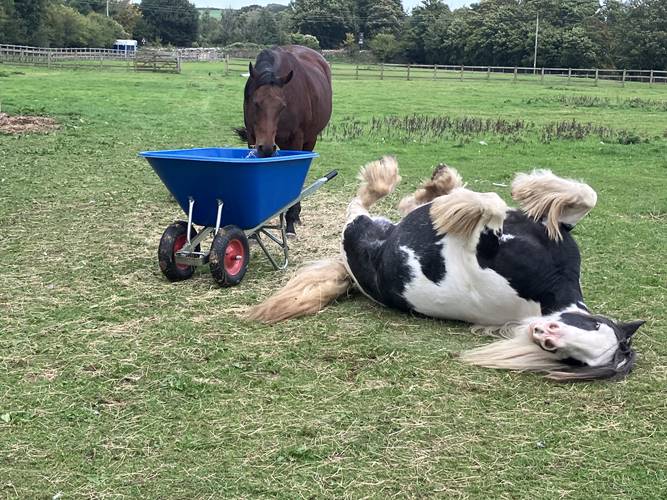
Dolly is a Gypsy Cob with a long, thick mane, a tail a la Rapunzel and thick feathers on each of her feet. Catching Dolly In full gallop is a ravishing sight. She has a way to jump, buck and shake her head that emphasises the natural beauty of her attributes and defines her as the little Lady that she is.
She is a Dolly!
I looked for her as a companion for Mikado who I rescued about 2 years before I got her. I was struglling so much with him that my friend Marie, who is teaching me natural horsemanship, encouraged me to get a second horse, but for myself. The thought was a scary one. My first response and deepest fear were that i was going to end up with 2 problems as opposed to 1.
I went on looking though, partly out of curiosity and partly hoping to find a horse that would suit my needs and my novice skills.
A few weeks or months later, i found Dolly, hidden away in North Devon. I asked my son to accompany me for moral support and we set off to get her, pulling our newly acquired horse box.
I never regretted it.
Has it been easy? Absolutely not!
Dolly is a Dolly, a little Madam, full of character and willfulness, but also, should I say it, full of charm and loveliness. She knows that it is easy to fool me and enjoys setting up challenges along the way, hurdles for me to jump, hoping to discourage me and get away with murder! She has a book full of magic tricks and goes through the table of contents wondering ...“Hmm!, Which one should I be pulling today!”
It is impossible not to fall in love with Dolly. She is undeniably cheeky, full to the brim with mischief and at the same time incredibly loving and respectuful - once i have learned how to earn her respect, that is. She may be pulling tricks on me but never goes beyond what I can't handle. She looks after me through the challenges she slkillfully sets up for me, which does nothing more than making me a better rider and a better human and which, above all strengthens our partnership and respect for each other.
She is a wonderful teacher and truly lives by her name:
Dolly Poppins!
FEBRUARY 2024
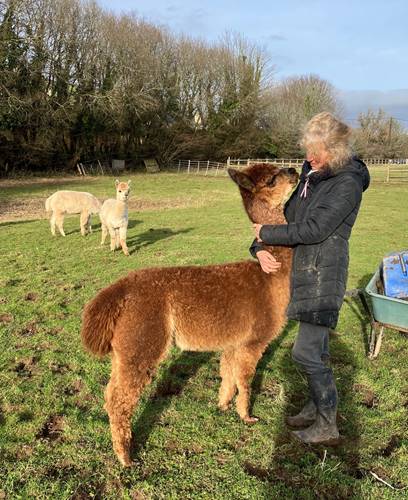
The Old Chapel of Ermington has openend its doors to guests and visitors of our Farm.
If you ever think of a short break in Devon and are visiting friends for a special occasion, we would be delighted to welcome you to stay in the large suite located in the old vestry of the building. It is a private space with its own entry, lounge and dining areas, an emperor size bed and a shower room.
The field is nearby and should you wish to meet our animals, we will love to introduce you to our alpacas, horses and goats. As you may have gathered from all our newsletters, I am passionate about my animals and would like nothing more than share my love for them.
The Old Chapel is also the home of Materia Aromatica and samples of our essential oils will be made available for you to test and experience.
The listing of the Old Chapel is on Airbnb with numerous pictures of the suite and of the animals. Just search for Ermington UK. Bookings can be made through Airbnb. Should you have any query, please contact Isabelle on 0776933907.
To know more about what we do, visit our Youtube channel
ALPACA TRAINING AT LIBERTY